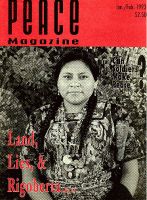
Peace Magazine Jan-Feb 1993, page 27. Some rights reserved.
Search for other articles by Ed Silva here
Robert Hackett, Norwood NJ: Ablex 1991
Robert Hackett, who teaches Communications at Simon Fraser University, has written an important book. Mainly about how and why newspapers cover "peace/security/defence" issues, it is the first extended treatment of its topic. There are at least three ways of reading this book. The busy peace worker who wants to be quite selective could limit herself to Hackett's sense of the peace movement as a creative and critical force inevitably having to deal with the media; a case study of generally positive Vancouver Peace Walks from 1980 to '87; and the concluding chapter, which urges that peaceniks continue to struggle for media space. These 60-odd pages will give a good idea of Hackett's basic perspective: the newspapers and the media more generally, are not simple transmission belts for either warmongers or peaceniks. Accordingly, the more the peace movement understands about how the press works, the easier will be its task of telling the press its side.
Peace educators and those with a taste for media work will want to go further into Hackett's book. They may want to look first at two chapters on "Canada's media system" and interviews with "peace and defence" journalists. These give a good sense of who specializes in peace coverage and how stories flow around the country and into papers. Another three chapters are the core of Hackett's contribution. Here he looks at how four defence groups (including the Department of National Defence) and three peace groups deal with the media-all trying to shape the national "peace and security" discourses. Three more case studies of media coverage might also be read here: the Toronto dailies on the U.S. raid on Libya, 1986; human rights violations reported in 13 English Canadian papers, 1979, 1984-85; and the "end of the Cold War." For me, the interview-based discussion of journalists and the defence/peace workers are the heart of this second and less hurried reading. Here the journalists seem wary of the peace publicists, the peace people seem positive about their work, while the "security" speakers seem-well, insecure about their control of the press
The third reading adds the first 86 pages, in which Hackett lays out various theories and academic positions on press and dissent coverage. Students of communications will enjoy these arguments. Hackett is especially keen to confront those who see the Canadian media as simple transmission belts of war-monger themes and ideas. He speaks for a newer vision in communication studies, one that sees media as depending on its audience's participation in order to gain its own ends (readers, profits). It is from this final and decisive dependency of media on its audiences that Hackett gives hope and strength to peace workers dealing with a seemingly overwhelming-but ultimately vulnerable-mass media. This book has several likely readerships. There is something valuable here for most Canadian peace workers.
Edward Silva is a sociology professor at the University of Toronto.

Peace Magazine Jan-Feb 1993, page 27. Some rights reserved.
Search for other articles by Ed Silva here